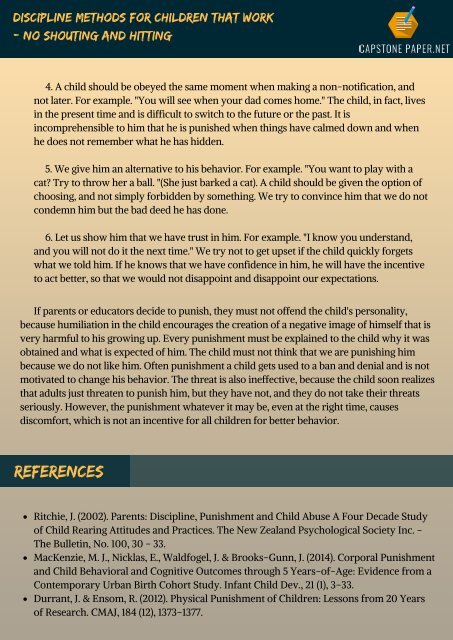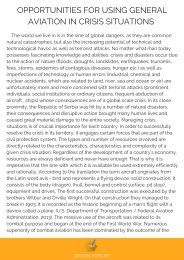Perspective Paper Example
Take a look at this great perspective paper example that we prepared for you. If you want to see more samples, visit https://www.capstonepaper.net/how-to-write-a-perspective-paper/
Take a look at this great perspective paper example that we prepared for you. If you want to see more samples, visit https://www.capstonepaper.net/how-to-write-a-perspective-paper/
Create successful ePaper yourself
Turn your PDF publications into a flip-book with our unique Google optimized e-Paper software.
DISCIPLINE METHODS FOR CHILDREN THAT WORK<br />
- NO SHOUTING AND HITTING<br />
4. A child should be obeyed the same moment when making a non-notification, and<br />
not later. For example. "You will see when your dad comes home." The child, in fact, lives<br />
in the present time and is difficult to switch to the future or the past. It is<br />
incomprehensible to him that he is punished when things have calmed down and when<br />
he does not remember what he has hidden.<br />
5. We give him an alternative to his behavior. For example. "You want to play with a<br />
cat? Try to throw her a ball. "(She just barked a cat). A child should be given the option of<br />
choosing, and not simply forbidden by something. We try to convince him that we do not<br />
condemn him but the bad deed he has done.<br />
6. Let us show him that we have trust in him. For example. "I know you understand,<br />
and you will not do it the next time." We try not to get upset if the child quickly forgets<br />
what we told him. If he knows that we have confidence in him, he will have the incentive<br />
to act better, so that we would not disappoint and disappoint our expectations.<br />
If parents or educators decide to punish, they must not offend the child's personality,<br />
because humiliation in the child encourages the creation of a negative image of himself that is<br />
very harmful to his growing up. Every punishment must be explained to the child why it was<br />
obtained and what is expected of him. The child must not think that we are punishing him<br />
because we do not like him. Often punishment a child gets used to a ban and denial and is not<br />
motivated to change his behavior. The threat is also ineffective, because the child soon realizes<br />
that adults just threaten to punish him, but they have not, and they do not take their threats<br />
seriously. However, the punishment whatever it may be, even at the right time, causes<br />
discomfort, which is not an incentive for all children for better behavior.<br />
REFERENCES<br />
Ritchie, J. (2002). Parents: Discipline, Punishment and Child Abuse A Four Decade Study<br />
of Child Rearing Attitudes and Practices. The New Zealand Psychological Society Inc. -<br />
The Bulletin, No. 100, 30 - 33.<br />
MacKenzie, M. J., Nicklas, E., Waldfogel, J. & Brooks-Gunn, J. (2014). Corporal Punishment<br />
and Child Behavioral and Cognitive Outcomes through 5 Years-of-Age: Evidence from a<br />
Contemporary Urban Birth Cohort Study. Infant Child Dev., 21 (1), 3–33.<br />
Durrant, J. & Ensom, R. (2012). Physical Punishment of Children: Lessons from 20 Years<br />
of Research. CMAJ, 184 (12), 1373–1377.


















